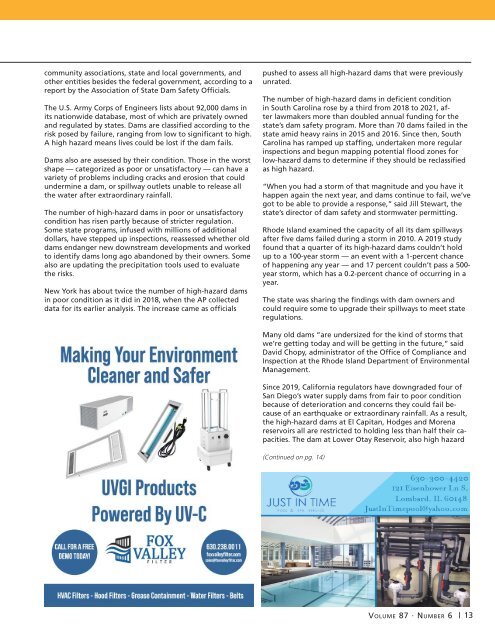CEAC-2022-06-June
Create successful ePaper yourself
Turn your PDF publications into a flip-book with our unique Google optimized e-Paper software.
community associations, state and local governments, and<br />
other entities besides the federal government, according to a<br />
report by the Association of State Dam Safety Officials.<br />
The U.S. Army Corps of Engineers lists about 92,000 dams in<br />
its nationwide database, most of which are privately owned<br />
and regulated by states. Dams are classified according to the<br />
risk posed by failure, ranging from low to significant to high.<br />
A high hazard means lives could be lost if the dam fails.<br />
Dams also are assessed by their condition. Those in the worst<br />
shape — categorized as poor or unsatisfactory — can have a<br />
variety of problems including cracks and erosion that could<br />
undermine a dam, or spillway outlets unable to release all<br />
the water after extraordinary rainfall.<br />
The number of high-hazard dams in poor or unsatisfactory<br />
condition has risen partly because of stricter regulation.<br />
Some state programs, infused with millions of additional<br />
dollars, have stepped up inspections, reassessed whether old<br />
dams endanger new downstream developments and worked<br />
to identify dams long ago abandoned by their owners. Some<br />
also are updating the precipitation tools used to evaluate<br />
the risks.<br />
New York has about twice the number of high-hazard dams<br />
in poor condition as it did in 2018, when the AP collected<br />
data for its earlier analysis. The increase came as officials<br />
pushed to assess all high-hazard dams that were previously<br />
unrated.<br />
The number of high-hazard dams in deficient condition<br />
in South Carolina rose by a third from 2018 to 2021, after<br />
lawmakers more than doubled annual funding for the<br />
state’s dam safety program. More than 70 dams failed in the<br />
state amid heavy rains in 2015 and 2016. Since then, South<br />
Carolina has ramped up staffing, undertaken more regular<br />
inspections and begun mapping potential flood zones for<br />
low-hazard dams to determine if they should be reclassified<br />
as high hazard.<br />
“When you had a storm of that magnitude and you have it<br />
happen again the next year, and dams continue to fail, we’ve<br />
got to be able to provide a response,” said Jill Stewart, the<br />
state’s director of dam safety and stormwater permitting.<br />
Rhode Island examined the capacity of all its dam spillways<br />
after five dams failed during a storm in 2010. A 2019 study<br />
found that a quarter of its high-hazard dams couldn’t hold<br />
up to a 100-year storm — an event with a 1-percent chance<br />
of happening any year — and 17 percent couldn’t pass a 500-<br />
year storm, which has a 0.2-percent chance of occurring in a<br />
year.<br />
The state was sharing the findings with dam owners and<br />
could require some to upgrade their spillways to meet state<br />
regulations.<br />
Many old dams “are undersized for the kind of storms that<br />
we’re getting today and will be getting in the future,” said<br />
David Chopy, administrator of the Office of Compliance and<br />
Inspection at the Rhode Island Department of Environmental<br />
Management.<br />
Since 2019, California regulators have downgraded four of<br />
San Diego’s water supply dams from fair to poor condition<br />
because of deterioration and concerns they could fail because<br />
of an earthquake or extraordinary rainfall. As a result,<br />
the high-hazard dams at El Capitan, Hodges and Morena<br />
reservoirs all are restricted to holding less than half their capacities.<br />
The dam at Lower Otay Reservoir, also high hazard<br />
(Continued on pg. 14)<br />
Volume 87 · Number 6 | 13


















